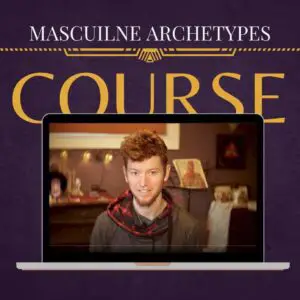When practicing meditation, you are getting in touch with the deepest parts of yourself. Some meditations help you feel a deep inner peace, love, and emotional healings, while other times, it can bring up trauma, uncomfortable feelings, and what many call the “shadow self.”
The Shadow will eventually come up during meditation, so understanding your Shadow and how to embrace it will be a valuable skill.
In the rest of this article, I will be sharing meditation tips for Shadow Work and guided meditations for embracing your Shadow.
New to Shadow Work? Check out this Starter Guide to Shadow Work
What Is Shadow Work In Meditation?
With regular meditation practice, you are bound to run into negative thoughts and unpleasant feelings. The dissonant and negative emotions often come from what Carl Jung called the Shadow, and Shadow work is how to heal/embrace these parts of yourself.
The conscious mind becomes less active with regular meditation, increasing your access to the subconscious.

The Shadow resides in the subconscious, so the deeper your meditation, the more likely the Shadow will start knocking on your door, so to speak.
During meditation, this can look like:
- Difficult Sensations
- Reliving Traumas
- Compulsive Behavior
- Negative Thoughts
- Remembering past Humiliation
- Anger
- Unresolved Emotions
- Depression
- Anxiety
A study by researchers from the University of California found that meditation can bring up a lot of negative feelings, loss of motivation, and past traumas. These are common side effects from your unresolved issues that are lingering in your Shadow.
When you first start meditating, having all this negativity might make you feel anxious or want to give up. You might be asking yourself.
Why is my head filled with negativity?
Why does meditation make me feel more restless?
I must suck at this because my mind is busier than ever.
I remember those questions when I first started. Every time I sat down to meditate, it felt like a battle against my past self and the future I wanted to move towards.
This dissonance was my Shadow wanting attention. After deep inner-work, I could unravel what I was afraid of and what helped me back. Having compassion for all the cruel things I have done and the negative behaviors I was trying to avoid freed my energy.
It made it easier to meditate and find inner peace.
Many of these feelings come from your ego, which really doesn’t want to look at the shadow aspects of your identity. It creates noise as a defense and will do whatever it can to get you to stop meditating.
But don’t worry… if you take the time to unravel the ego and embrace your Shadow, then meditation becomes a lot easier.
Shadow Work: Does it Help meditation?
Shadow Work helps you move past subconscious blockages that can come up during meditation. If you don’t face your Shadow, you can find yourself stuck in negative behaviors and a vicious cycle of negativity during meditation.
A study in The Scientific World Journal found that meditation, shadow work, and dreamwork helped significantly raise people’s self-esteem and self-awareness.
Benefits of Shadow Work and Meditation:
- Feeling whole or integrated as a person
- It calms your conscious mind
- Easier to practice compassion towards others when you have compassion towards your Shadow.
- Increase self-respect, self-confidence, and self-esteem
- Help turn down the mental chatter
How do you do Shadow Work?
Shadow Work is about consciously shedding light on the things you are trying to avoid.
All of us have parts of our identity that we would rather not admit, such as guilt, sexual desires, traumas, and negative behaviors.
Often we just try and pretend like those things don’t exist.
Shadow Work is about recognizing these parts of yourself with compassion.
This process naturally comes up in meditation, but a few techniques can make it easier.
- Work with a therapist, particularly someone with an understanding of shadow work and depth psychology.
- Writing prompts are a great way to explore the Shadow and begin the process of healing. >>> Check out this article on Shadow Writing Prompts
- Guided Meditations that explore the Shadow. (I will be sharing meditations later in this article.)
- Rituals that help you connect and heal the Shadow. >>> Check out this article on ritual practices you can use to heal the Shadow.

LEARN MORE: I also have an entire article about utilizing shadow work in your spiritual practice.
Guided Meditation to Embrace Your Shadow Self
A helpful technique for connecting with the Shadow is guided meditation. When you are deeply present with yourself, you can tap into the deepest parts of yourself.
I created a guided meditation based on the teachings of Robert Johnson, Carl Jung, and some of my favorite meditation teachers.
The meditation is designed to give you a safe space to connect to the inner child, explore past wounds, and embrace your shadow self.
You can do this meditation often, and you will find each time it uncovers a different aspect of yourself.
Below is a written-out script you can read for others or yourself.
Pro Tip: Record yourself reading the script on your phone and play it back.

Shadow Work Meditation Script
Find yourself in a comfortable position.
When you are ready, breathe in deeply, hold, and exhale.
Breathe in 1…2…3…4… hold…1…3…exhale 1…2…3…4…5…
Repeat this breath 3 more times.
Now scan your body for any tension. Notice if you feel any tightness in the feet, legs, chest, shoulders, or head.
When you find a place of tension or discomfort, take a moment and breath into it. Ask yourself if there is any emotion associated with this tightness.
What it is trying to do for you?
Is it trying to protect you in some way?
What is it trying to remind you?
Concentrating on that pain/discomfort, try and travel back in time to when it first came up. When was the moment you first recognized the feelings that came up through your body sensations?
A memory might surface, a word, or a situation when you were younger.
How old were you then?
What happened at that time?
What were you learning?
Take a moment to watch your younger self and the situation. Allow yourself to feel whatever was happening.
Now imagine your older self coming into view next to your younger self.
Take a moment to embrace your younger self, telling yourself it is ok, that it’s ok to be imperfect and to be learning.
Remind yourself that you are not alone.
Give younger self-love and empathy.
Did your younger self push anything away to deal with this pain? Did you learn any sets of behavior to deal with this feeling?
Take a moment to reflect on this.
Can you accept these parts of yourself? The negative patterns you might have learned? The guilt around it?
You don’t have to change it, just accept it.
Now feel yourself coming back to the current time and space. Feel yourself back in your body.
If you have the time, write down your experience and what you have learned.
Best Shadow Work Meditations:
Shadow Work is a profoundly personal and ever-evolving practice.
I wanted to give you multiple options for meditations on the Shadow. Helping you find the best resource for your particular situation.
I have also found that the Shadow is best approached from multiple angles/lenses. That way, you get a more holistic view of your Shadow and how to integrate it.
6 Best Guided Meditations For Shadow Work:
Here is another great meditation by Dr. Rachel Greenberg that you can find for free on Insight Timer.

Should I Do Shadow Work Before Or After Meditation?
In general, it is best to do shadow work during or after meditation. It is common for your Shadow to come up during meditation. It can be a nagging voice, past shame, or unresolved feelings. You can work through this during the meditation or try and separate time after the session.
Your Shadow will inevitably come up, so it is better to consciously set aside time to explore it instead of having it bubble up unexpectedly during every meditation.
I have found that if I do shadow work before meditation, the whole meditation will be centered around my Shadow. It can be fine if it’s what I want.
For myself, I find it best to set time for shadow work and allow my meditations to be a space for other introspection and spiritual exploration.
If my Shadow comes up during meditation, I will usually try and breathe through it and see if any wisdom surfaces naturally.
Sometimes I just don’t want to deal with it, and I will write down a note about getting back to this aspect of myself later. It usually makes that part of my Shadow feel heard and allows me to relax back into my mediation.
Here is the key… if you say you are going to give your Shadow space later, you should follow through.
In Conclusion:
If you are starting your meditation journey or have been practicing for a while, there is a lot to be gained through Shadow Work.
Shadow Work helps:
- Unravel past traumas
- It helps you remove limiting beliefs
- Calms the negative chatter during meditation
I have seen the power of Shadow Work in my own meditation and members of men’s groups and sangha’s I have been a part of over the last decade.
In my own practice, I was really stumped. I was constantly hitting the same negative thoughts. I had layers upon layers of limiting beliefs due to my Shadow.
I thought I wasn’t worthy of universal love.
I thought I was too broken to practice meditation and find inner peace.
With time and self-awareness of my Shadow, I realized that these thoughts came from a deep fear. I was trying to protect myself from being abandoned and unloved. I wrapped up those fears in my Shadow.
Only after I faced these shadows was I able to move forward in my meditation practice.
Shadow work has been instrumental in my ability to find peace and healing through meditation.
If you are interested in Shadow Work and Spirituality, check out these other articles I have written:




